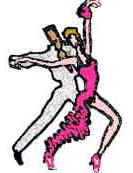You
are here: DanceSport >
CSTD replies
CSTD
replies to commentary...
Following is the reply of CSTD to the article
we ran earlier questioning CSTD's credentials. CSTD president
Leslie P. Newman submitted this in the Dance
Addict's Forum. Let the reader
decide.
 The Commonwealth Society of Teachers of Dancing
The Commonwealth Society of Teachers of Dancing
Suite 2, 8 Shelley Street, Richmond, Victoria 3121 Australia
Telephone: +613 9428 2983 Fax: +613 9428 5022
August 18th, 1999
DANCESPORT POLITICS - AUSTRALIAN OR OTHERS HAVE NO PLACE IN THE
PHILIPPINES
By: Leslie P. Newman, O.A.M., F.A.M.I.
President, C.S.T.D.
It was fascinating to read 'Dance Addict's Guide' and the comments headed "A
PEEK INTO DANCESPORT POLITICS," and in particular the misinformation about
this Society.
SO...... LET'S LOOK AT THE FACTS!!!.
WHAT'S RIGHT AND WHAT'S WRONG AND WHY IS THERE A "SPIN" ON EVEN
WHAT'S RIGHT?
So what is the Commonwealth Society of Teachers of Dancing (C.S.T.D.)?
Fact 1:
A democratically constituted dance society established in Australia 66 years
ago offering examinations in various dance disciplines including ballroom (or
Dancesport if you prefer that label) throughout Australia and the Asia Pacific
Region.
Fact 2: One of eight professional dance societies in Australia who are the 'member
bodies' of the Australian Dancing Board which was established in 1964.
Fact 3: The Australian Dancing Board is the Australian member of the World Dance &
Dance Sport Council (W.D.& D.S.C.) which is the controlling body for the world
of professional Dancesport.
Fact 4: There are 16 dance societies in Australia 'recognized' by the Australian
Dancing Board some of which operate on a state only basis.
Fact 5: The C.S.T.D. conducts a range of activities in Australia outside of it's examining
role. These include Dancesport Championships and festivals, workshops and other
member service activities.
Fact 6: The C.S.T.D., after advising Ms. Becky Garcia of the Dance Sport Council of the
Philippines during a discussion in Manila last November (1998) of our planned
response to the enquiries for ballroom exams in the Philippines, has provided
teacher training and examinations in the Philippines. We are also responding to similar requests from other countries in the region.
Fact 7: No dance society can be a member of the W.D. & D.S.C. countries are
members. The same situation would seem to exist with the I.D.S.F.
Fact 8: The I.D.S.F. (International DanceSport Federation) developed from the former
International Council of Amateur Dancers. The W.D. & D.S.C. and the
I.D.S.F. have a long standing 'Joint Agreement' and
a joint committee to address matters of mutual concern between amateurs
and professionals.
Fact 9: At international level dance politics are part of the world scene as individual
factions and people push their own agenda. In microcosm this is reflected in Australia and perhaps in other countries.
Fact 10: The C.S.T.D. is in the Asia Pacific Region for the long haul. Our
commitment to the region is an ongoing one. Our stated objective in our Constitution is "to encourage the art of dance."
What's wrong 1: The C.S.T.D. has "probably less than 10 'ballroom
members'". RUBBISH!!!
Over a period of 66 years the number of professional dance exams at Teacher
Diploma (Member) level in the various ballroom syllabi may well exceed that of
other Societies AND no informed professional could question the 'quality' of the
examination.
What's wrong 2: The C.S.T.D. has no "intention...to set up a foreign controlled dance teaching
examination system (or) to mimic the methods used by the English dance
teaching Societies."
What we will do is to provide access to countries in the region to an
international examination system in the dance disciplines in which we offer our
syllabi.
What's wrong 3: If the C.S.T.D. "does not have any Australian Government recognition"
(whatever that means). What are various C.S.T.D. syllabi recognized by State Governments in Australia? Why are we invited to sit on the "Reference Group"
for an Australian Government funded programme to establish Interim National
Competency Standards applicable to all forms of dance to lead national
teaching standards for recognition by the Australian National Training
Authority?
Why was the President, Les Newman, OAM honored in 1996 under the
Australian Order of Australia Honours system with the Order of Australia Medal
(OAM) for "service to ballroom dancing?"
What's wrong 4: If "the C.S.T.D has no status internationally", how did it become established in
Singapore, Malaysia, Thailand, China, Brunei, India, the Philippines and other
countries and why are we being invited into other countries in the region?
AND NOW..... SOME QUESTIONS
Question 1: Who is the un-named "source in Australia" who provided the misinformation
about C.S.T.D and more importantly what was his/her objective?
Question 2: Why is there a "spin" on what's right in the "PEEK INTO DANCESPORT
POLITICS?"
Question 3: (and an answer) Who is Les Newman?
President, Commonwealth Society of Teachers of Dancing (since 1976)
Director, Australian Dancing Board (since 1977 and this is current)
Appointed Australian Dancing Board Delegate to the World Dance &
Dancesport Council in 1988 and has represented Australian Dancing Board at
W.D.&D.S.C. meetings in that capacity most years since then and is eligible for
re-appointment in 2000 should he choose to make himself available.
Elected Chairman, Australian Dancing Board in 1988 and served for three
years.
Series Consultant to the television series "THAT'S DANCING" during its three
year run on national television in Australia on the Australian Broadcasting
Corporation's television network (1989 to 1991).
AND IN CONCLUSION
In many countries it seems the ballroom dance scene is ridden with politics - the
Philippines does not need this problem and the C.S.T.D is proud to stand on
it's record of sixty six years of service to dance.
Les Newman, OAM
President

|
